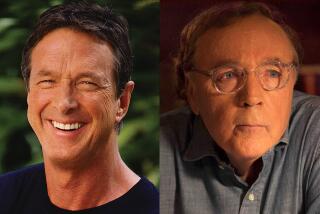Waves of Emotion for Adolescent Hero
The Impact Zone
By Ray Maloney (Delacorte Press: $14.95)
Stotan!
By Chris Crutcher (Greenwillow Books: $10.25)
As early as 1802, education specialist Sarah Trimmer distinguished between books for children and those for adolescents, defining “all young gentlemen and ladies to be children till they are 14 and young persons till they are at least 21.”
As Neil Postman has argued in “The Disappearance of Childhood,” it may be true that accelerated maturation in the age of crack and the pill, and the indiscriminate diffusion of stories and images that were once the exclusive province of adults, has drastically abbreviated the period of “childhood,” obliterating many distinctions between today’s jaded adolescents and infantile adults.
Nevertheless, there remains as ever the first sexual experience, first love, fledgling relations with parents and peers, and the first faltering steps in the lifelong process of seeking one’s identity.
A Thriving Industry
And as the two books under review make amply clear, there exists a thriving literary industry for the still extant and tumultuous adolescent sensibility. When done well, these books recapture the exaltations, despairs, posturings, and restless anxiety of young adults.
In Ray Maloney’s “The Impact Zone,” 15-year-old Jim Nichols, a surfer, has run away from Ventura to Oahu to find his father and himself. There’s ample terror as he is hit by 25 separate waves and ground bloody on the reefs before he gets into the barrel of the murderous “Pipeline,” a dangerous funnel of water created by cresting waves.
Adolescent Emotion
The “impact zone” of the title is where the big waves smash, the place that mauls the careless and overconfident. But it’s also the impact zone of adolescent emotion where young Jim lives his terrors and his achings.
Particularly painful for Jim is the prospect of living with his stepfather, a compulsive list-maker who wears socks to the beach, racist blatherer, squisher of insects and computer-addicted designer of missiles.
Jim finds his real father soon after arriving in Hawaii. As much a superhero as the stepfather is a straw-man, he’s handsome and muscular, an idealized surfer. But in one of the book’s climactic scenes, when Jim decides to take on the ocean’s lethal Pipeline, we see that he still holds considerable hostility for the father who left him: For one moment Jim wants to “drive the sharp nose of (his) board right through his head, like a spike going through an orange.” But the notion vanishes, and Jim says he never wants to know where it came from.
This is a touching book that overcomes its own cliches. Its design is firm, its concern deep; its heart in the right place.
Chris Crutcher’s “Stotan!” also takes on a worthy issue. The title--meaning a combination of Stoic and Spartan heroism--is the coinage of Korean-descended Max Il Song, swimming coach for Frost High School in Spokane, Washington. Max’s four super athletes, the book’s heroes, train to exhaustion through Stotan Week, thinking the pool is the test that matters.
Then reality is disclosed and mortality strikes one of the members of the closely-knit clan. It soon becomes clear that the test is larger, more serious than a swim
And so the true meaning of the gnomic Max’s wisdom is revealed: “The magic (is) not in gritting your teeth and enduring the pain with no show or emotion. It was in letting go; accepting reality, what is. . . . “
Crutcher’s book doesn’t have the structure, coherence, unity of “The Impact Zone.” Many of the events seem contrived, and for all their crises, the characters are shallow.
Still, Crutcher’s intent is the worthy and serious recognition of Job’s question: Why do the evil prosper and the innocent suffer? And Crutcher’s answer is not cheap. As Lenny Bruce said once, “The what-should-be never did exist. . . . There is only what is.” Fit matter for today’s young adults.
More to Read
Sign up for our Book Club newsletter
Get the latest news, events and more from the Los Angeles Times Book Club, and help us get L.A. reading and talking.
You may occasionally receive promotional content from the Los Angeles Times.






